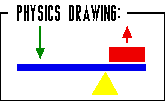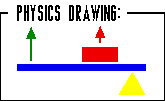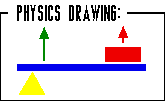The Machines
Levers
A lever is a device that is used to lift a load. A lever is a plank laid over a special type of wedge that is known as the fulcrum. You apply an input force to one end of the lever and the force is exerted on the object at the other end. This typically gives you what is known as a mechanical advantage, which is discussed in detail in section two of the introduction. If you do not understand mechanical advantage you should not be reading this page.
There are three sub-classes of levers which are discussed in detail on this page.
Class One Lever
A class one lever has the effort on one end, the fulcrum in the middle and the load force at the opposite end. This a drawing of a class 1 lever:

A class one lever.
Drawing Analysis:
- Green Arrow: The green arrow represents the input force. Forces are expressed in Newtons (N).
- Red Arrow/Box: This represents the output force of the lever, also known as the load. If you are working against gravity then this will always be the objects weight in Newtons.
- Yellow Triangle: This is the fulcrum of the lever.
There are a few things you should know about class 1 levers. The first is that they reverse the direction of the force. When you push down the lever presses up on the load. Also note that the closer the fulcrum is moved to the load the more mechanical advantage that the lever has.
Class Two Lever
A class two lever has the effort in between the fulcrum and the input force such as pictured below:

A class two lever.
Drawing Analysis:
- Green Arrow: The green arrow represents the input force. Forces are expressed in Newtons (N).
- Red Arrow/Box: This represents the output force of the lever, also known as the load. If you are working against gravity then this will always be the objects weight in Newtons.
- Yellow Triangle: This is the fulcrum of the lever.
A class two lever does not change the direction of the force applied to it. The mechanical advantage of this lever can be increased by moving the resistance force closer to the fulcrum.
Class Three Lever
A class three lever has the input force located between the fulcrum and the load force. This lever has a very interesting property which is discussed in detail below. Here is what a class three lever looks like:

A class three lever.
Drawing Analysis:
- Green Arrow: The green arrow represents the input force. Forces are expressed in Newtons (N).
- Red Arrow/Box: This represents the output force of the lever, also known as the load. If you are working against gravity then this will always be the objects weight in Newtons.
- Yellow Triangle: This is the fulcrum of the lever.
A class three lever is special because it has a mechanical advantage of less than one. This means that you must put in more force than you get out of it. While this is impractical for most applications there may be some times when you have more than enough force available to lift an object but you need distance.
Mechanical Advantage & Levers
Levers work at a mechanical advantage to lift a load. This mechanical advantage can be calculated one of two ways that it is described in the second section of the introduction. The following is a mechanical advantage problem:
Joe uses a lever to lift a 200 N rock a distance of 4 meters. If the force Joe used to press down on the rock was 10 N what is the mechanical advantage? How far did Joe have to push to get the rock to move 4 meters?
Select the appropriate answer and hit the 'answer' button:
|


